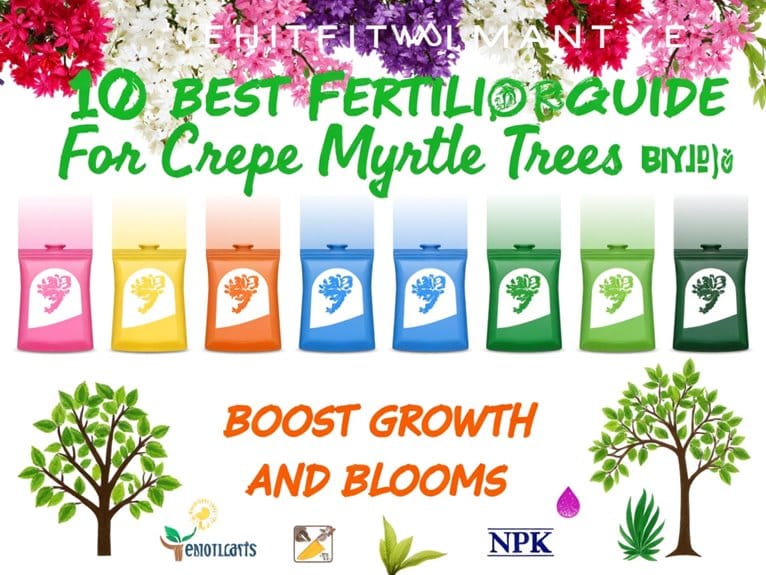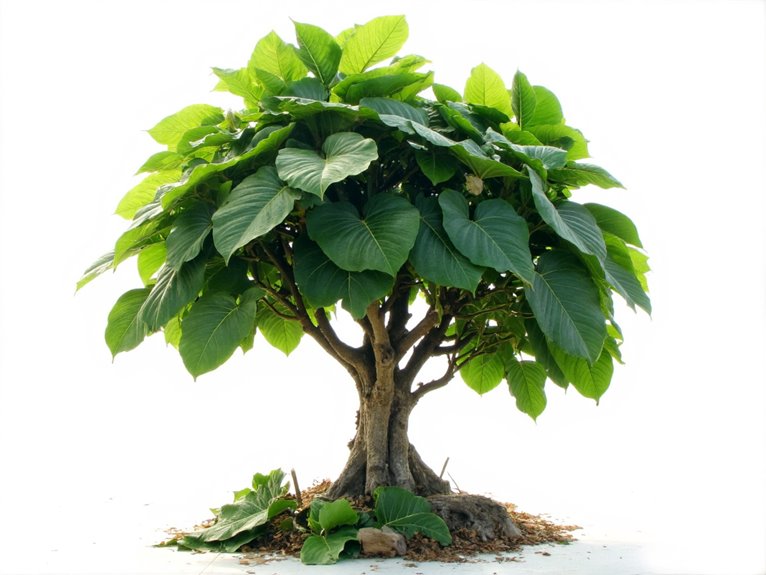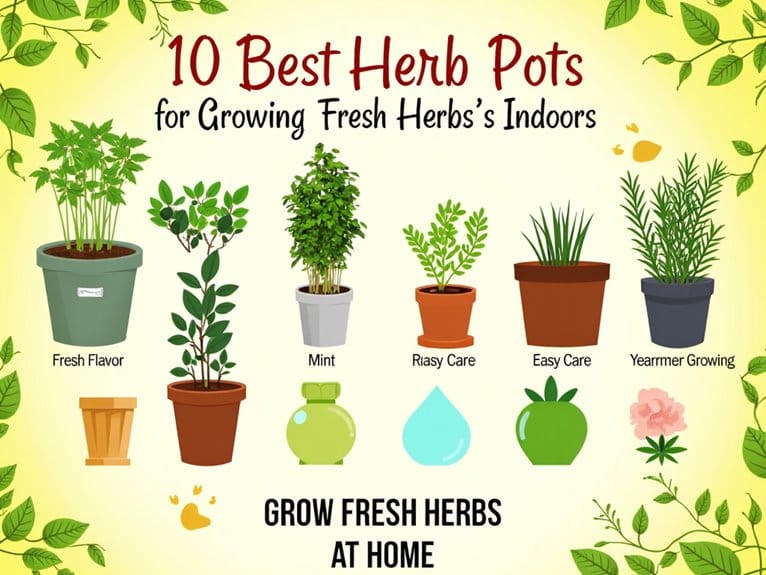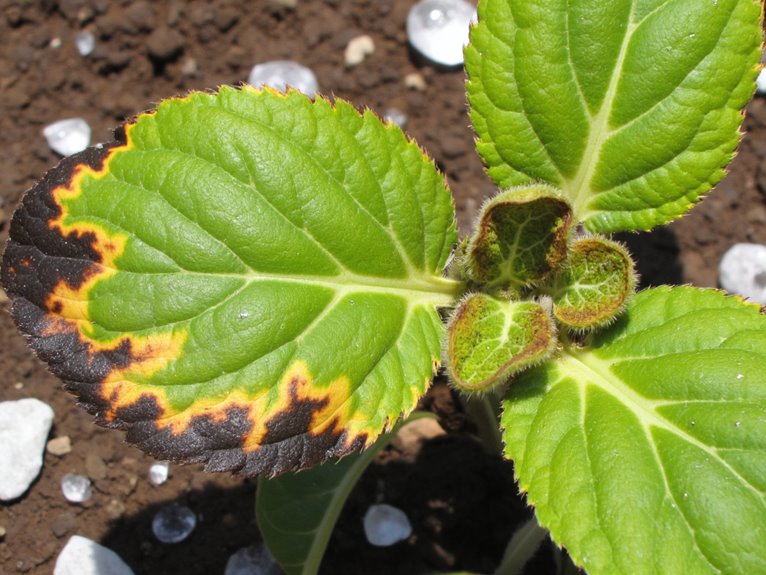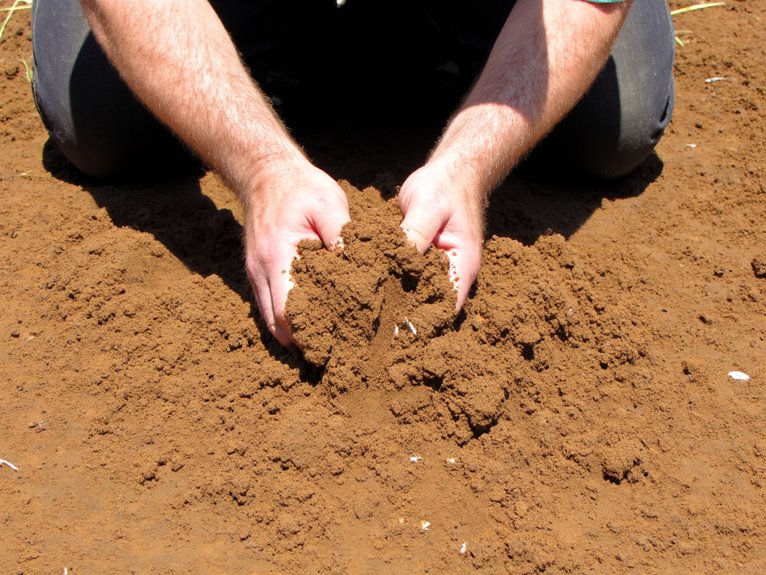Not Supporting Tall Plants: Staking Mistakes That Lead to Broken Stems
You might be setting your tall plants up for disaster with improper staking techniques. Restrictive ties can girdle trunks and block growth, while rigid materials cause abrasion. Instead, use flexible, breathable straps that allow natural movement – this helps build strength. Remember to remove stakes after one season at latest, as prolonged dependency creates weak stems. Proper placement is key too; avoid major root clusters and position supports strategically. Don’t let your plants rely on artificial support forever – they need to develop their own resilience.
Notable Insights
- Restrictive staking prevents natural trunk flexibility crucial for resilience against wind and weight.
- Over-tightened ties damage bark, restrict nutrient flow, and create weak points in developing trunks.
- Prolonged staking dependency hinders taper development, resulting in spindly stems prone to breaking.
- Improper stake placement near roots causes long-term structural weaknesses in plant support systems.
- Using rigid materials like wire or hard ties abrasively damages trunks and prevents necessary movement for strength.
High Staking and Structural Weakness
High staking can set trees up for structural failure if not used carefully. When you restrict trunk movement, you cut off its natural signal to develop flexibility and strength—no sway, no girth growth. This makes the stem more prone to breakage later. High stakes often cause Stem girdling when materials rub against the bark, cutting off nutrient flow and weakening the tree’s core. The result? A trunk that can’t handle wind or weight, especially after stakes are removed. Remember, trees need to bend slightly to build resilience; rigid support robs them of this chance. Give your plants space to grow strong, not just tall.
Over-Tightening Staking Materials
As we consider how staking supports young trees, it’s important to recognize that even well-intended practices can backfire when not done carefully. Over-tightening creates tie pressure effects that damage bark, restrict growth, and weaken stems. Materials with poor stretch properties compound this risk by failing to loosen as plants grow.
Avoid tight knots or rigid ties that dig into trunks—use soft, wide straps designed for trees. Check every few weeks and always leave enough space for natural movement. A stem should sway slightly, not be held in place by constricting bands.
This risk is particularly evident when excessive staking occurs, as it can compromise a tree’s ability to develop its own structural strength. Support should guide, not restrain—let plants grow strong on their own timeline while offering just enough help to stay upright until they’re ready to stand alone.
Prolonged Staking Dependency
Although proper staking helps young trees stand tall, leaving them dependent on supports for too long can actually weaken their natural ability to develop strength. Stake Duration Studies show that trees need gradual independence from stakes to build resilient trunks and flexible root systems through Root Stake Interaction. When stakes remain past the establishment phase, trees fail to develop necessary taper and structural integrity. This dependency creates spindly trunks that collapse when supports are removed. Trees also miss opportunities for roots to anchor themselves through natural movement. Live stake planting demonstrates that minimal intervention can lead to successful streambank stabilization with species like silky dogwood, buttonbush, and elderberry. Regular monitoring of plant health helps identify when supports are no longer needed, similar to how gardeners check for pest presence and damage indicators. Instead of investing in long-term staking solutions, focus on proper timing—remove stakes after one growing season unless extreme conditions demand extended support. Let trees learn to stand on their own!
Incorrect Stake Placement Techniques
When placing stakes for your plants, positioning them correctly is vital to avoid harming the plant while providing necessary support. A height mismatch can cause stems to bend or break, while material rigidity may prevent natural movement. Let’s explore proper placement:
| Distance from Stem | Soil Depth | Risk |
|---|---|---|
| Too close | Shallow | Root damage |
| Ideal (5 cm) | Deep (15 cm) | Minimal stress |
| Too far | Deep | Leaning & breakage |
Position stakes before planting or at an angle toward the stem. Avoid placing them near major roots and make sure they’re deep enough to stay stable as plants grow taller. For tomatoes specifically, consider using comprehensive support systems that include triangle stakes with grow bags to provide enhanced stability for vertical growing. Remember, the goal is support without restriction — keep your plant’s growth needs in mind!
Using Inappropriate Staking Materials
If you’re staking plants, the materials you choose can either help or hurt—imagine wires scratching bark like sandpaper or rigid ties holding stems completely still. Inappropriate material selection often causes more damage than support; abrasive ropes girdle trunks, while hard ties restrict natural movement essential for stem strength. These rigid tie effects on growth patterns prevent proper trunk tapering and weaken woody tissue. Always use flexible, breathable materials that allow some sway—elastic bands or padded straps work best. Avoid wires, plastic tubes, or narrow cords that concentrate pressure on small areas. Remember to remove staking materials after one growing season; leaving them on longer harms root development and creates permanent structural weaknesses. Choose appropriately sized ties that fit your plant’s thickness without digging into the bark. For those who struggle with maintaining healthy plants despite proper staking, consider high-quality artificial alternatives that provide the aesthetic appeal of greenery without the risk of damage from improper support techniques.
Environmental Factors Exacerbating Stem Breakage
After ensuring your plants have appropriate support through flexible staking materials, you might still face unexpected challenges—like winds that sway even the strongest stems or droughts that make them brittle and prone to snap. High winds can literally snap stems, especially if they’re not acclimated to outdoor conditions or if stakes are placed in open areas. Compacted soil exacerbates this vulnerability by restricting root growth, limiting nutrients that strengthen stem tissue. A garden bed with heavy clay soil near a patio door might seem stable, but foot traffic compacting the soil creates both physical pressure on roots and reduced water uptake, making stems more likely to break under stress.
Frequently Asked Questions
What’s the Ideal Stake Height for Most Plants?
The ideal stake height is about half to two-thirds your plant’s mature size. Don’t let pot size impact it — choose stakes that match the expected height. Material matters too; wood, bamboo, or metal offer different support levels based on what you’re growing.
Can I Use Electrical Tape as a Plant Tie Substitute?
Can’t use electrical tape as a plant tie substitute – it’s too sticky and restricts airflow. Electrical tape safety risks include stem damage from adhesive strength and tight wrapping. Better tie material options let plants grow without injury.
How Often Should I Check Staked Plants During Growth?
You should check staked plants weekly at least, more often for fast growers. Consider stake placement techniques and Tie material alternatives like soft fabric or elastic bands to avoid girdling. Adjust as they grow and inspect after storms or high winds.
Do All Tall Plants Need the Same Level of Support?
No, not all tall plants need the same support – some require sturdier stakes while others benefit more from trellises. Vertical Ventilation affects how much your plants need to grow up, and Root Restriction can make them more fragile at height.
Will Removing Stakes Harm My Independently Standing Plants?
No, removing stakes won’t harm your independently standing plants if done properly. Stake height impact matters – keep stakes low enough to allow natural trunk thickening. Tie material comparison is key: use flexible options like cloth or elastic instead of rigid metal or plastic to prevent bark damage.
On a final note
By avoiding these staking mistakes, you’ll help your plants grow strong and tall without the risk of broken stems. Remember to stake properly from the start, use gentle methods, and let plants develop their own support when possible. With care and knowledge, you can guide your garden to thrive—no broken stems needed. Your efforts make a real difference in your plants’ health and happiness.


